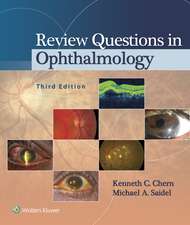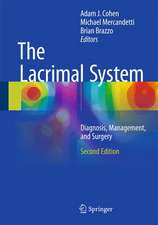Risk Prevention in Ophthalmology
Editat de Marvin Krausharen Limba Engleză Paperback – 19 feb 2008
Preț: 369.10 lei
Preț vechi: 388.52 lei
-5% Nou
Puncte Express: 554
Preț estimativ în valută:
70.64€ • 76.70$ • 59.33£
70.64€ • 76.70$ • 59.33£
Carte tipărită la comandă
Livrare economică 23 aprilie-07 mai
Preluare comenzi: 021 569.72.76
Specificații
ISBN-13: 9780387733401
ISBN-10: 038773340X
Pagini: 282
Ilustrații: XVII, 282 p.
Greutate: 0.43 kg
Ediția:2008
Editura: Springer
Colecția Springer
Locul publicării:New York, NY, United States
ISBN-10: 038773340X
Pagini: 282
Ilustrații: XVII, 282 p.
Greutate: 0.43 kg
Ediția:2008
Editura: Springer
Colecția Springer
Locul publicării:New York, NY, United States
Public țintă
Professional/practitionerCuprins
General Considerations.- Basic Medical Malpractice Terminology.- The Defense Attorney.- The Plaintiff's Attorney.- The Trial Judge.- The Medical Expert.- Sequence of Events in a Medical Malpractice Lawsuit.- Informed Consent.- The Five Most Effective Risk Prevention Strategies.- Revelation of Adverse Events and the Conundrum of an Apology.- Risk Management in the Ophthalmic Subspecialties and Related Fields.- Anesthesia.- Cataract Surgery.- Cornea: External Disease and Contact Lenses.- Drugs.- Emergencies.- Glaucoma.- Neuroophthalmology.- Oncology.- Ophthalmic Plastic Surgery.- Pediatric Ophthalmology.- Refractive Corneal Surgery.- Retina and Vitreous.- Uveitis.- Personal and Business Considerations.- Physician and Defendant: Living and Coping with a Double Life.- Medical Malpractice Insurance: Selection of Companies and Policies.
Notă biografică
Dr. Kraushar is an adjunct professor at Mt. Sinai in New York, but spends the bulk of his time in private practice. Dr. Kraushar has been in practice for nearly twenty years and had published literally dozens of articles in the most highly cited ophthalmology journals discussing the issue of medical malpractice. Unusual among presenters at the American Academy of Ophthalmology because he is not primarily an academic doctor, he nonetheless has chaired multiple symposia at the AAO annual meeting on the subject.
Textul de pe ultima copertă
In Risk Prevention in Ophthalmology, many of the questions surrounding medical malpractice are answered clearly, concisely and pragmatically for physicians, by physicians. Written with an emphasis on clinical matters, this book shows ophthalmologists how to avoid lawsuits in the first place. What does "risk assessment" mean in the real world? How truly informed are your patients after signing your consent forms? Do your patients have reasonable expectations regarding outcomes? Are your history-taking and record keeping habits leaving you exposed? Are you sufficiently careful with documentation? What is quality assurance?
TOPICS COVERED: Causes of litigation. Poor communication. Cataract surgery. Retinal detachment. Prescribing and drugs. Glaucoma. Trauma and Intraocular foreign bodies. Medical retina. Retinopathy of prematurity. Anesthesia. Oculoplastic. Strabismus. Tumors. Neuro-ophthalmology. Why patients sue. The four most effective risk prevention techniques. Identifying and managing the litigious patient. Natural history of a medical malpractice claim. Hiring your own attorney. Selection of an expert witness. Discovery. Interrogatories. Examination before trial (deposition). Consideration of settlement. Trial testimony and courtroom behavior. Damages w Appeal.
Covering the legal issues for all of the areas of subspeciality in ophthalmology, Risk Prevention in Ophthalmology provides the busy clinician with the tools necessary to reduce not only the risk of potential lawsuits, but also insights for coping with actual ones.
TOPICS COVERED: Causes of litigation. Poor communication. Cataract surgery. Retinal detachment. Prescribing and drugs. Glaucoma. Trauma and Intraocular foreign bodies. Medical retina. Retinopathy of prematurity. Anesthesia. Oculoplastic. Strabismus. Tumors. Neuro-ophthalmology. Why patients sue. The four most effective risk prevention techniques. Identifying and managing the litigious patient. Natural history of a medical malpractice claim. Hiring your own attorney. Selection of an expert witness. Discovery. Interrogatories. Examination before trial (deposition). Consideration of settlement. Trial testimony and courtroom behavior. Damages w Appeal.
Covering the legal issues for all of the areas of subspeciality in ophthalmology, Risk Prevention in Ophthalmology provides the busy clinician with the tools necessary to reduce not only the risk of potential lawsuits, but also insights for coping with actual ones.
Caracteristici
Written by an ophthalmologist in practice for more than twenty years, this book takes a medical, not legal, approach to explain to physicians how to avoid litigation in the first place Includes supplementary material: sn.pub/extras










